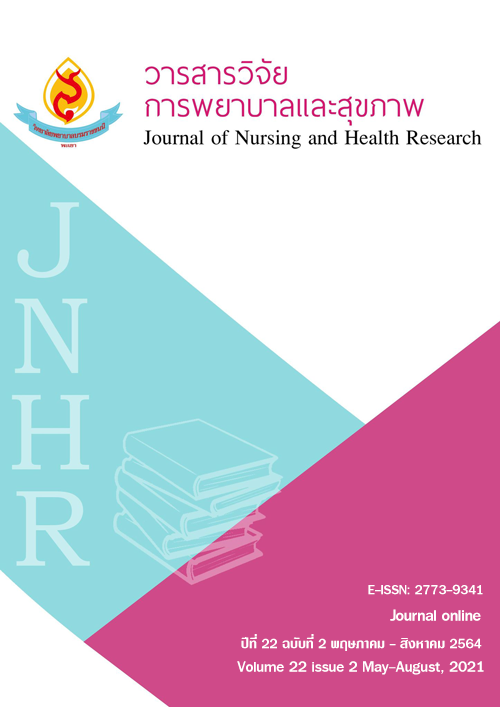การพัฒนานวัตกรรมการเรียนรู้ในการป้องกันพฤติกรรมการกลั่นแกล้งและ การถูกกลั่นแกล้งทางไซเบอร์ในเยาวชนไทย
คำสำคัญ:
นวัตกรรมการเรียนรู้, พฤติกรรมการกลั่นแกล้งทางไซเบอร์, การถูกกลั่นแกล้งทางไซเบอร์บทคัดย่อ
การวิจัยนี้ใช้รูปแบบการวิจัยและพัฒนา มีวัตถุประสงค์เพื่อพัฒนานวัตกรรมการเรียนรู้เพื่อป้องกันพฤติกรรมการกลั่นแกล้งและถูกกลั่นแกล้งทางไซเบอร์ และ 2) ประเมินประสิทธิผลของนวัตกรรมการเรียนรู้เพื่อป้องกันพฤติกรรม การกลั่นแกล้งและถูกกลั่นแกล้งทางไซเบอร์ ขั้นตอนวิจัยมี 5 ขั้นตอน ดังนี้ 1) ศึกษาแนวคิดทฤษฎีที่เกี่ยวข้องเพื่อป้องกันพฤติกรรมการกลั่นแกล้งและถูกกลั่นแกล้งทางไซเบอร์ 2) สร้างต้นฉบับนวัตกรรมการเรียนรู้เพื่อป้องกันพฤติกรรมการกลั่นแกล้งและถูกกลั่นแกล้งทางไซเบอร์ 3) ตรวจสอบประสิทธิภาพของนวัตกรรมการเรียนรู้ในกลุ่มตัวอย่าง จำนวน 10 คน 4) ปรับปรุงต้นฉบับนวัตกรรมการเรียนรู้ 5) ทดลองใช้ในกลุ่มตัวอย่างที่มีขนาดใหญ่ เพื่อประเมินประสิทธิผล ของนวัตกรรม กลุ่มตัวอย่าง คือ เยาวชนไทยที่มีอายุ 13 - 18 ปี ในโรงเรียนเขตอำเภอเมือง จังหวัดลำปาง วิเคราะห์ข้อมูล โดยใช้สถิติ ค่าเฉลี่ย ส่วนเบี่ยงเบนมาตรฐาน dependent t-test และ independent t-test ผลการศึกษาคือ นวัตกรรม การเรียนรู้ในการป้องกันพฤติกรรมการกลั่นแกล้งและการถูกกลั่นแกล้งทางไซเบอร์ ที่ใช้หลักการรู้เท่าทันการใช้สื่อดิจิทัล (digital literacy) เป็นเวปไซต์สำเร็จรูป สำหรับให้ผู้เรียนศึกษาเรียนรู้ด้วยตนเอง มีเนื้อหาประกอบด้วย การให้ความรู้เกี่ยวกับปัจจัยที่ทำให้เกิดการกลั่นแกล้งและถูกกลั่นแกล้งทางไซเบอร์ ผลกระทบของการกลั่นแกล้งและถูกกลั่นแกล้งทางไซเบอร์ และมีการฝึกหัดจากสถานการณ์จำลองของแต่ละบุคคล ตามแนวคิดทักษะการรู้เท่าทันการใช้สื่อดิจิทัล ได้แก่ 1) ทักษะการรักษาอัตลักษณ์ที่ดีของตนเอง 2) ทักษะการจัดการเวลาหน้าจอ 3) ทักษะการจัดการกับการคุกคามบนโลกออนไลน์ 4) ทักษะการจัดการความปลอดภัยของตนเองในโลกออนไลน์ 5) ทักษะการจัดการความเป็นส่วนตัว 6) ทักษะการคิดอย่างมีวิจารณญาณ 7) ทักษะการจัดการข้อมูลที่เป็นร่องรอยบนโลกออนไลน์ และ 8) ทักษะการใช้เทคโนโลยีดิจิทัลอย่างมีจริยธรรม และแบบประเมินพฤติกรรมการกลั่นแกล้งและการถูกกลั่นแกล้งทางไซเบอร์ด้วยตนเอง ผลการประเมินประสิทธิผลของนวัตกรรมการเรียนรู้พบว่า ภายหลังการทดลองใช้นวัตกรรมการเรียนรู้ กลุ่มทดลองมีคะแนนพฤติกรรมการกลั่นแกล้งและถูกกลั่นแกล้งทางไซเบอร์ต่ำกว่าก่อนการใช้นวัตกรรมการเรียนรู้ อย่างมีนัยสำคัญทางสถิติ (p < .05) และมีคะแนนพฤติกรรมการกลั่นแกล้งและถูกกลั่นแกล้งทางไซเบอร์ต่ำกว่ากลุ่มควบคุมอย่างมีนัยสำคัญ ทางสถิติ (p < .05) ดังนั้น หน่วยบริการทางสุขภาพและสถานศึกษา ควรนำนวัตกรรมการเรียนรู้ในการป้องกันพฤติกรรมการกลั่นแกล้งและการถูกกลั่นแกล้งทางไซเบอร์ มาให้เยาวชนในสถานศึกษาได้ใช้งาน เพื่อเพิ่มความรู้และทักษะในการป้องกันพฤติกรรมการกลั่นแกล้งและการถูกกลั่นแกล้งทางไซเบอร์
เอกสารอ้างอิง
กฤติศักดิ์ อนุโรจน์ และ ณัทธร พิทยรัตน์เสถียร. (2562). การศึกษาความเที่ยงและความตรงของแบบสอบถาม cyber–aggression perpetration and victimization scale ฉบับภาษาไทยวารสารสมาคมจิตแพทย์แห่งประเทศไทย, 64(1), 45-60.
ชัชฎา อัครศรีวร นากาโอคะ และกฤชณัท แสนทวี. (2562). ปัจจัยที่มีอิทธิพลต่อการรู้เท่าทันข้อมูลและสื่อดิจิทัลของเยาวชนในเขตกรุงเทพมหานคร. วารสารวิชาการนวัตกรรมสื่อสารสังคม, 7(1),56-62.
ชินดนัย ศิริสมฤทัย. (2561). การรับรู้ ทัศนคติ และความตั้งใจในการเกิดพฤติกรรมการกลั่นแกล้งบนโลกไซเบอร์ (นิเทศศาสตรมหาบัณฑิตมหาบัณฑิต). บัณฑิตวิทยาลัย, มหาวิทยาลัยกรุงเทพ.
ณัฐกานต์ จันทรศิริพุทธ. (2560). ความสัมพันธ์ระหว่างความถี่ของการรังแกในพื้นที่ไซเบอร์กับการเผชิญปัญหาของเหยื่อ: อิทธิพลส่งผ่านของการประเมินทางปัญญาโดยมีความเป็นนิรนามของผู้กระทำเป็นตัวแปรกำกับ (วิทยานิพนธ์ศิลปศาสตรมหาบัณฑิต). บัณฑิตวิทยาลัย, จุฬาลงกรณ์มหาวิทยาลัย.
ธันยากร ตุดเกื้อ, เกษตรชัย และหีม, และ ฤทัยชนนี สิทธิชัย. (2562). แนวทางการป้องกันพฤติกรรมการรังแกบนโลกไซเบอร์ของนักเรียนมัธยมศึกษาในสามจังหวัดชายแดนภาคใต้. วารสารพฤติกรรมศาสตร์เพื่อการพัฒนา, 11(1), 91-106.
นิตยา วงศ์ใหญ่. (2560). แนวทางการพัฒนาทักษะการรู้ดิจิทัลของดิจิทัลเนทีฟ. Veridian E-Journal, 10(2), 1630-1642.
บุบผา เมฆศรีทองคำ. (2554). การรู้เท่าทันสื่อ: การก้าวทันบนโลกข่าวสาร. วารสารนักบริหาร, 31(1), 117-123.
ปองกมล สุรัตน์. (2561). สาเหตุและผลกระทบที่เกี่ยวข้องกับการรังแกผ่านโลกไซเบอร์: กรณีศึกษาเยาวชนไทยผู้ถูก รังแก. วารสารวิชาการ สถาบันเทคโนโลยีแห่งสุวรรณภูมิ, 1(4), 640-642.
พีรวิชญ์ คำเจริญ และ วีรพงษ์ พลนิกรกิจ. (2561). เด็กกับการรู้เท่าทันดิจิทัล. วารสารวิชาการนวัตกรรมสื่อสารสังคม สาขามนุษยศาสตร์ และสังคมศาสตร์, 6(2), 25-26.
มูลนิธิศูนย์พิทักษ์สิทธิเด็ก. (2559). เมื่อเด็กถูกเพื่อนรังแกในโรงเรียน...ผู้ใหญ่จะช่วยเหลืออย่างไร?. สืบค้นเมื่อ 24 ธันวาคม 2560, จาก http://www.thaichildrights.org/article/57698
สกาวฟ้า จันทภาโส, นฤมล ศิระวงษ์, และแจ่มจันทร์ ศรีอรุณรัศมี. (2563). การพัฒนาแอปพลิเคชันเพื่อสร้างความ ตระหนักรู้เรื่องการระรานทางไซเบอร์สำหรับนักเรียนชั้นมัธยมศึกษาปีที่ 1. วารสารวิชาการอุตสาหกรรม ศึกษา, 14(1), 56-69.
อุษา บิ้กกิ้นส์. (2555). การรู้เท่าทันสื่อและสารสนเทศ. วารสารสุทธิปริทัศน์, 26(80). 147-161.
Association of college and Research Libraries. (2000). Information literacy competency standard for higher education. Retrieved November 2, 2020, from https:// alair.ala.org/bitstream/ handle/11213/7668/ACRL%20Information%20Literacy20%Competency%20standards%20for%20Higher%20Education.pdf?sequence=1&isAllowed=y/
Cyberbullying Research Center. (2015). 2015 Cyberbullying data. Retrieved November 27, 2020 From http://cyberbullying.org/2015-data
Del, R. R., Casas, J. A., & Ortega, R. (2016). Impact of the Conred program on different cyberbulling roles. Aggressive Behavior, 42(2), 123-135.
Patchin, J. W., & Hinduja, S. (Eds.). (2012). Cyberbullying prevention and response: Expert perspectives. Routledge.
Salmivalli, C., & Poskiparta, E. (2012). Making bullying prevention a priority in Finnish schools: the kiva antibullying program. New Directions for Youth Development, 133, 41-53.
Slonje, R., Smith, P. K., & Frisén, A. (2013). The nature of cyberbullying, and strategies for prevention. Computers in human behavior, 29(1), 26-32.
Tural, S. & Ercan, F. (2017). Traditional and cyberbullying co-occurrence and its relationship to psychiatric symptoms. Pediatric International, 59(1), 16-22.
World health Organization. (2015). Youth violence: the health sector role in prevention and response. Retrieved September 6, 2020, From http://www.who.int/violence_injury_ prevention/violence/youth-violence-infographic-2015.pdf?
ดาวน์โหลด
เผยแพร่แล้ว
รูปแบบการอ้างอิง
ฉบับ
ประเภทบทความ
สัญญาอนุญาต
ลิขสิทธิ์ (c) 2021 วารสารวิจัยการพยาบาลและสุขภาพ

อนุญาตภายใต้เงื่อนไข Creative Commons Attribution-NonCommercial-NoDerivatives 4.0 International License.



